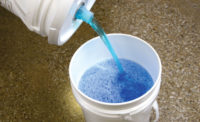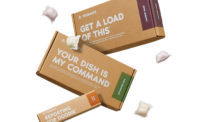Market Trends: Household Packaging
The Power of Clean in Household Packaging
With consumers putting more thought into household product buys, thought should also go into the packaging.








Are you happier when your house is clean? If so, you’re not alone. According to a survey by Clorox, 80 percent of consumers report feeling more relaxed in a clean space, while 72 percent say they are more productive and 60 percent are less stressed. It is therefore no surprise that consumers put thought into purchasing cleaners, surface disinfectant, dish detergent and other household products. It should be environmentally friendly, made of natural ingredients and have a clean, fresh smell—no harsh chemical odors, please.
So, what else goes into choosing household products and what do consumers look for on shelves? Steve Caldeira, president and CEO of the Household & Commercial Products Association (HCPA), shared his take on what we can expect to see in household packaging, including three-in-one products, refillables and on-the-go sizes.
What is the HCPA?
CALDEIRA: Our mission is to protect, promote and enhance the household and commercial products industry, and the lives of consumers and workers who use our members’ products. HCPA is known as the trade association that works collaboratively and proactively to get things done.
Why the new name and tagline?
CALDEIRA: The new HCPA brand will more clearly reflect who we serve. The change is the result of a nearly year-long process that was based on the findings of comprehensive research, multiple focus groups, and key member and stakeholder input. The new tagline, “Innovative Products for Home. Work. Life.” underscores the industry’s commitment to consumers and workers, and affirms the substantial role household and commercial products play in every aspect of our daily lives.
OK, on to the nitty gritty: What household packaging trends do you expect to see in 2018 and the near future?
CALDEIRA: The median American household income increased again in 2017, the second year of growth in a row. Households are seeing the benefits of the economic recovery and low inflation, which is altering what types of products and packaging are most appealing. The stable economy also gives consumer product goods companies the freedom to pursue more innovative strategies—like bringing smaller start-ups into their brand portfolio or reintroducing a previously successful product—particularly in the areas of health and wellness.
Natural attributes will continue to increase in prominence across all categories of consumer goods, including household and commercial products. Packaging that reflects these characteristics will continue to grow in popularity as late adopters enter the space and early adopters fine-tune high performing products for the increasingly discerning consumer.
What are the benefits consumers seek when purchasing household products?
CALDEIRA: Price continues to be the critical decision-making factor, followed by efficacy. However, it is well known that consumers are interested in products that make life simpler, even if it is at a higher price point. Packaging is a critical factor in that simplicity—it can enable formulas that combine steps and speed up household chores, such as three-in-one products, refillables and on-the-go sizes.
Is there a lack of development in household packaging design?
CALDEIRA: While there has been a lot of innovation in the household product space, we are somewhat unique in the strength of the relationship between our brands and consumers. Consumers depend on these products to keep them healthy—whether it is at work or at home or on the go. A product that keeps you clean, that keeps you from getting sick, that helps keep you safe, creates a unique level of trust with consumers. This relationship is reflected in their loyalty to the tried and true packaging and designs that they associate with that trust. That doesn’t mean that consumers aren’t open to trying something new, just that they also expect those trusted products to be there when they need them.
What are you hearing from CPGs in this sector?
CALDEIRA: As major CPG companies choose to incorporate circular economy principles into their operations, we’re going to see the ripple effects throughout the value chain—from ingredients and packaging to the store and beyond. The circular economy holds the promise of dramatic innovation and cost savings, but as with many other industry-wide changes, the winners and the losers will be separated by their strategic investment and timing and their willingness to focus on the big picture versus short-term gains.
The Household & Commercial Products Association, formerly known as the Consumer Specialty Products Association, is a trade association representing companies that make and sell $180 billion annually of products used for cleaning, protecting, maintaining and disinfecting homes and commercial environments. HCPA member companies employ 200,000 people in the U.S. whose work helps consumers and workers create cleaner, healthier and more productive lives.
For more information, visit TheHCPA.org.
|
STANDOUT DESIGNS Here, we look at two household products that recently launched with new packaging, as well as a new premade pouch that is sure to attract packagers’ attention. The Honest Company collaborated with Berlin Packaging (berlinpackaging.com) to redevelop their laundry product line while staying true to its mission “to empower people to live happy, healthy lives.” With e-commerce shipping environment in mind, the company called on Berlin for a complete redesign of the line that would be sturdy enough to make it to the consumer’s doorstep without damage. Berlin’s design division, Studio One Eleven, recognized that a dosing closure would be crucial to the redesign. The custom-designed cap is secure enough to survive harsh handling during shipping. The bottle structure employs a thick liner to minimize the assembly gap and ensures a robust seal with unscrewing threads for protected assembly, and ribs to create sealing surface. The design has a longer cut-out spout that increases airflow and provides controlled pouring. The handle allows for one-handed gripping/pouring, and the weight of the bottle improves drop resistance. With three different sizes, the large label panel prominently displays the brand’s messaging. The Easy range from Easy Cleaning Solutions Ltd (Formerly Jeyes) has rebranded part of its household range with a decorative shrink sleeve solution from Clondalkin Flexible Packaging Bury (clondalkingroup.com). Two variants of the sleeves were printed in eight-color UV flexo for the 1-liter fabric conditioner and 750ml liquid detergent. With reverse printing on the sleeve, the print is protected from discoloration and damage from spills. The PET sleeve also provides a scuff-resistant cover for the print. Unlike labels, shrink sleeves encompass the entire container covering angular and contoured areas, allowing more space for imagery and text. Using clever artwork placement, shrink sleeves give a 360-degree view of the design without distorting the image. “We decided to move away from the original label packaging and opted for a shrink sleeve solution as it offered us the high-end, quality feel that we wanted for this particular range,” said Tom Brooks, commercial director from Easy Cleaning Solutions. Our monthly online reader poll asked “Where will we see the most change in household packaging in coming years?” With a resounding 45 percent answering “more use of pouches,” it’s no wonder Glenroy (glenroy.com) keeps adding to its roster. The new turnkey premade STANDCAP Pouch was designed for squeezable products that require clean, controlled dispensing. This easy-to-use, gravity-fed pouch provides mess-free dispensing, 99 percent product evacuation, and instant shelf impact. The package is lightweight, easy to use and eliminates the need for a utensil when dispensing the product. The pouch’s innovative closure features an easy-open flip-cap and a customizable anti-spill SimpliSqueeze valve for clean and controlled drip-free dispensing. It also allows consumers to easily squeeze out every last drop of product. The pouch package was designed for on-the-go convenience. To stay ahead of the curve in the household sector, keep to the tried and true, while marrying larger sized products with refillables for large households and on-the-go sizes for smaller households. Remember that consumers are aiming for eco-friendly, easy pour/open and trusted brands. |
Looking for a reprint of this article?
From high-res PDFs to custom plaques, order your copy today!










